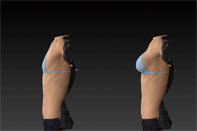The de-facto standard for beauty for men has long been the Clint Eastwood-esque rugged look. Sun-weathered faces and wrinkled age lines combined to make most men look like extras in a 1960’s western movie.
Not so much anymore. As more and more men reach age 30-40, they start to realize that proper diet and exercise are not enough to stave off the effects of aging. They are turning to injectable fillers to help retain (or recapture) their youthful looks. More commonly known as “Brotox”, the injectable filler for men craze is just taking off.
In this day and age, society places a higher than ever value on youth and beauty. Especially in such subcultures as tech, IT and finance. If you’re older than “29” you’re considered a dinosaur in these industries. It’s no surprise why more and more men are opting for injectable fillers to help remain competitive. Not only for women and love, but for their careers as well.
30 going on 50
One of the most noticeable signs of aging is the human face. As men get older, we tend to get wrinkles in places where there were no wrinkles prior.
- Forehead
- Sides of eyes (aka “crow’s feet”)
- Jowl area
- Chin and cheekbones
They say that the face is one of the first things we notice about someone new we meet, and within a matter of seconds our brains pick up subtle visual cues about that person. Wrinkles on the forehead, slightly greying hair, crow’s feet around the eyes are all signs that you’re not in your prime anymore.
While genetics and healthy living habits contribute greatly to how gracefully we do (or don’t) age, fillers can temporarily help thwart the signs of aging.
Women have been the biggest consumers of injectable filler products. In fact, it’s been reported that only 10% of men have gotten an injectable filler over the past 15 years. This is probably due in part to a cultural and social stigma regarding men who are would seem overly concerned about their looks.
Celebrities/Culture
Over the past 100 or so years, Hollywood has been a driving force in the cultural and fashion traditions of Americans. If you ask most people what they think is “manly”, the start to conjure up images of the rugged cowboy throwing bales of hay into the back of a Dodge RAM pickup truck. Or maybe such celebrities as Robert Redford and Clint Eastwood with their wrinkled foreheads and faces. Someone like Barry Manilow would never be thought of as a “manly” kind of man.
But times are changing. You’d might be surprised to learn that Clint Eastwood has lost the wrinkles on his forehead as have many other male celebrities. It seems as if the societal standard for beauty for men has gone from the rugged Marlboro Man to the guy who uses facial creams to keep his skin looking silky smooth.
A major part of men wanting to stay young looking is so that they can retain upward mobility in their careers. Especially in such industries as IT and tech, a high value is placed on youth because they are considered to be the innovators and the driving forces of change. Long gone are the wrinkled 60-year-old CEO’s and execs.
If you work in an industry that places a heavy value upon youth and looks, perhaps it’s time to start looking into injectable fillers to help remain competitive?
Injectable Fillers F.A.Q.’s
If you’re a guy and you’re considering (or at the very least researching) injectable fillers, there are a few things you should be aware of.
For example, injectable fillers are only temporary. It’s been said that the first application will last anywhere from 3-5 months, and then you’ll need to get them again every 3 months thereafter if you want to keep the wrinkles at bay.
The cost for injectable fillers for men is slightly higher than it is for women. This is because men tend to have more wrinkles on their faces than do women. You’re usually charged by the amount of filler that’s used on your face.
There will be somewhat of a small sting when the doctor injects the needle. The overall pain level has been described as a “small pinch”. Nowhere near enough to make you cry out in pain or wince, but enough to let you know it’s there.
It may take several days to several weeks for the injectable fillers to do their job (by completely ironing out the winkles in your face). You may notice some tightening of the skin depending on where it was injected.
It should also be noted that not all doctors are the same. Injecting fillers into the human face can carry a small risk, but more importantly, if not done properly it can make you look like a circus clown.
“Trout pout”, “Chipmunk cheeks”, and “Pillow Face” are all names given to people who have had poor quality work done to their faces. The best way to prevent this is to avoid doctors and “skin clinics” who offer discount injectables. Sometimes called “Groupon Botox”, these businesses only care about getting people in and out of the office…just like cattle. If they have to resort to offering a coupon to get people to visit them, chances are they’re not very good at what they do.
“Brotox”: Fad or Here to Stay?
Hollywood is no longer the primary driving force that dictates what we should look like. It can be said that the tech industry and the subcultures that spring up around it are influencing more and more people as the years go by. These kinds of subcultures place a heavy value and emphasis on staying and looking young. After all, the companies these subcultures come from were built on innovation created by the youth…not stuffy old men in 3-piece suits sitting in the board room.
Injectable fillers for men is exponentially growing in popularity, now that the stigma of vanity for males is gone. Age lines and wrinkles on a man’s face no longer symbolize manliness – it’s more of a sign that they’re beyond their prime and out of the proverbial game. Injectable fillers can help shave at least 10 years off of your face. If performed by a qualified and competent doctor, only you and your doctor will know that you’ve had work done.
If you’re a man and considering injectable fillers, contact Dr. Adams in Dallas, TX to set up an appointment. Having 10 years proverbially shaved off your face can do wonders for your career, love life and most importantly your self-esteem.















